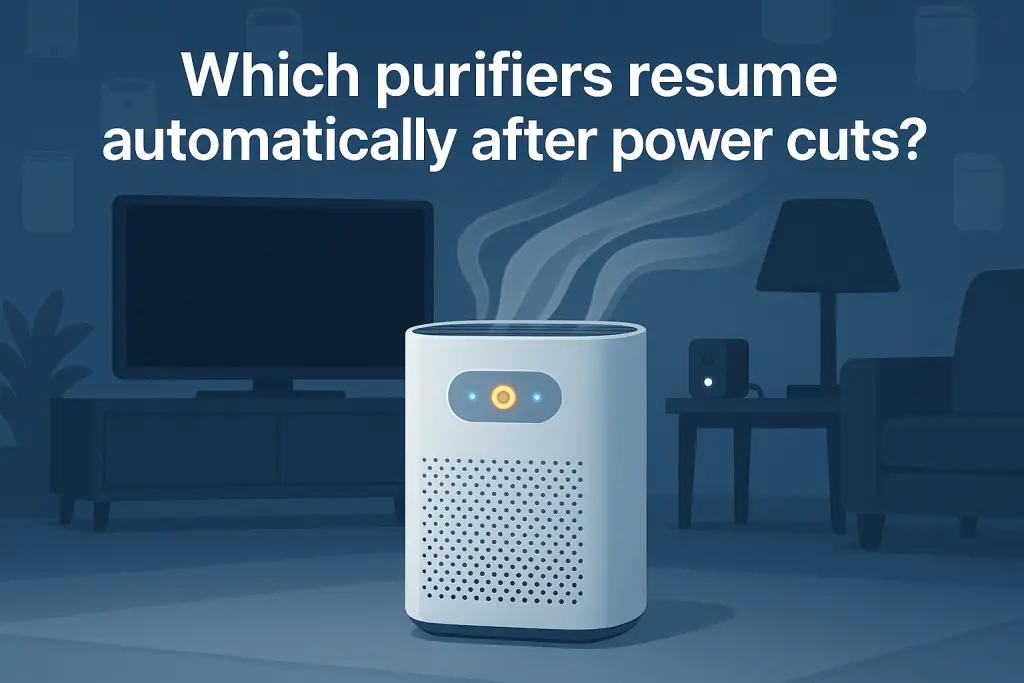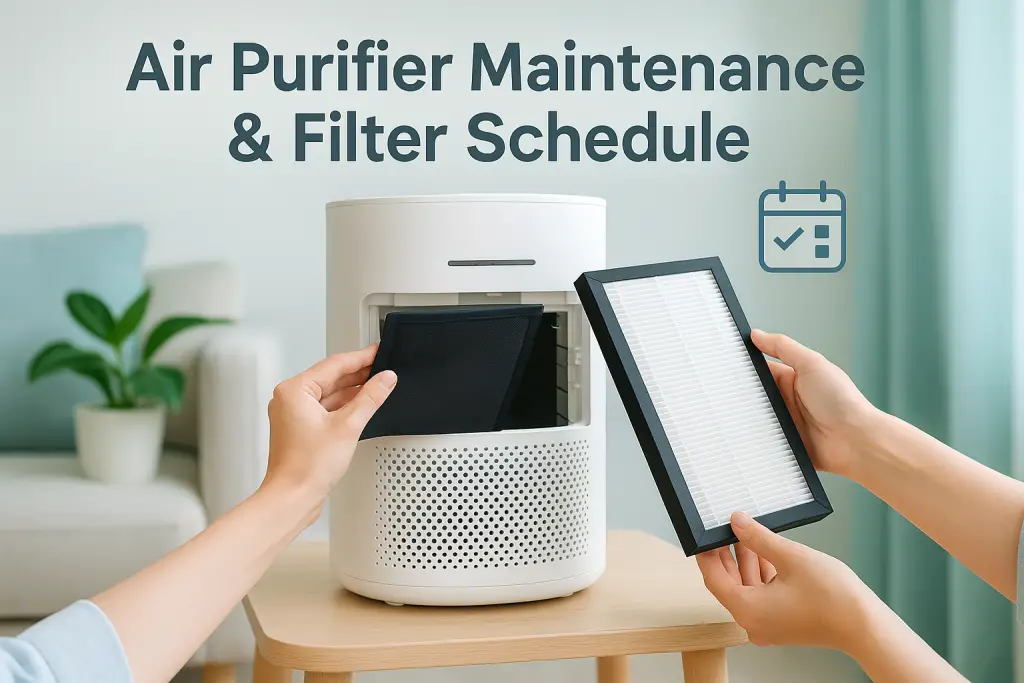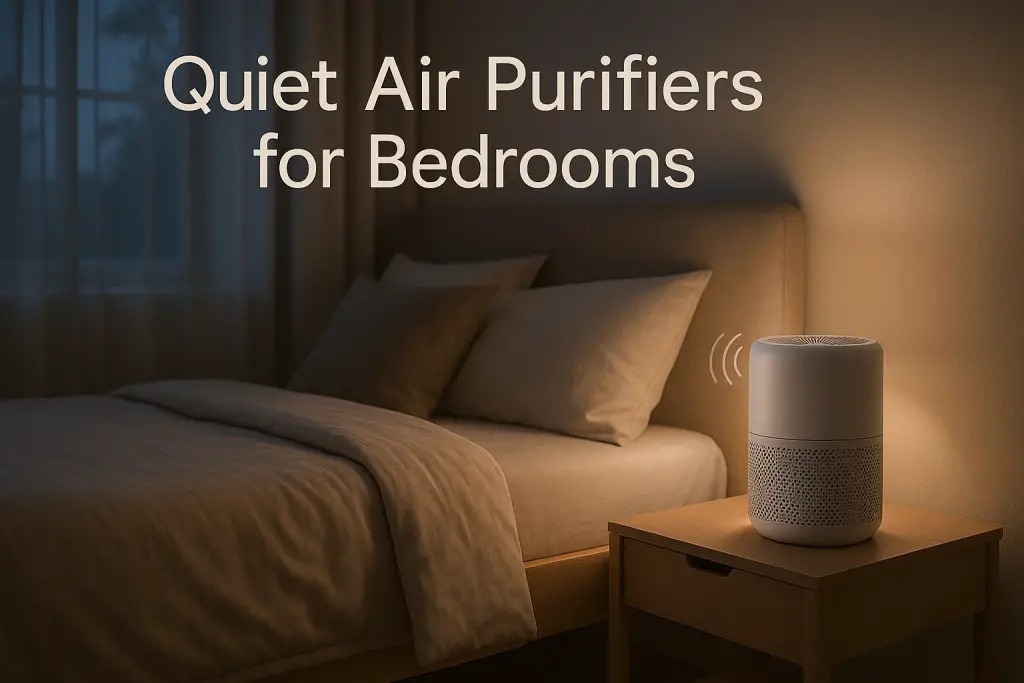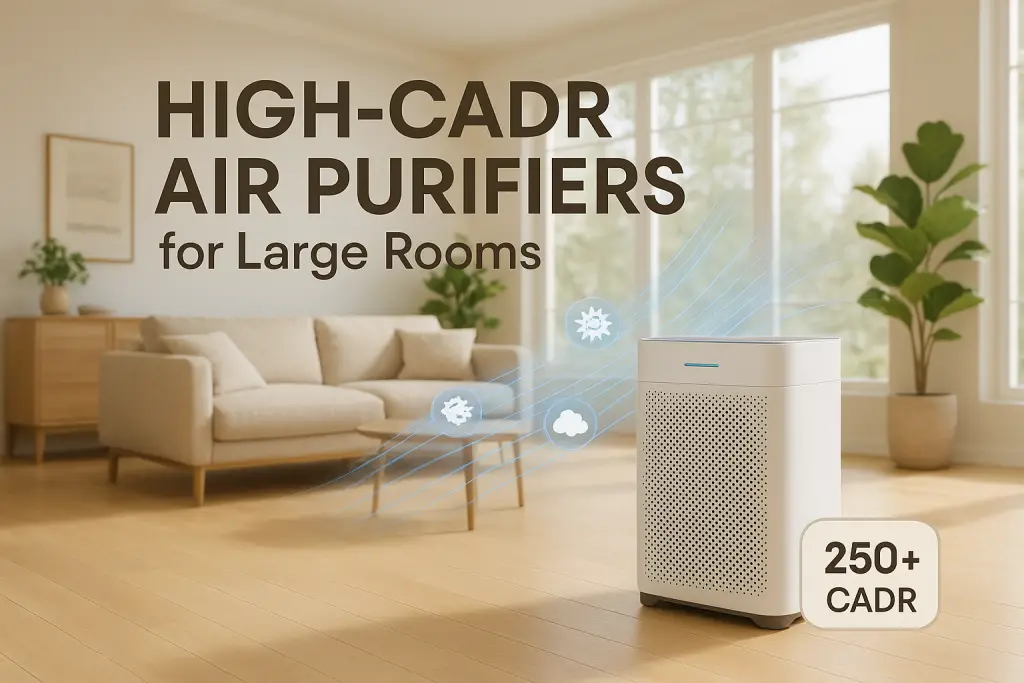When the power goes out, your air purifier shuts down, letting pollutants accumulate. Air purifiers with auto-restart functionality automatically resume operation once electricity returns, maintaining continuous air cleaning without manual intervention. This feature is particularly valuable in areas with frequent power fluctuations or for people with respiratory conditions who need consistent air filtration.
Understanding Auto-Restart vs. Memory Function in Air Purifiers
Auto-restart and memory function are two different features often confused when discussing how air purifiers behave after a power outage. Here’s what each term actually means and why the distinction matters:
Auto-restart capability means the air purifier will automatically power back on and resume operation when electricity returns after an outage. The unit starts running again at its previous settings without requiring any user interaction.
Memory function means the air purifier remembers its previous settings (fan speed, mode, timer) when it’s turned back on, but it requires you to manually press the power button after a power cut. Many quiet air purifiers for bedrooms include this feature for user convenience, but it’s not the same as true auto-restart.
Most air purifiers don’t have true auto-restart due to safety considerations. Manufacturers design units to remain off after power disruptions to prevent fire hazards from unattended devices reactivating unexpectedly. This design follows electrical safety principles that protect consumers from potential risks.
The benefits of auto-restart include:
- Continuous air filtration even during your absence
- Maintenance of air quality standards without manual intervention
- Peace of mind during frequent power fluctuations
- Critical protection for those with respiratory conditions
Which Purifiers Resume Automatically After Power Cuts? 11 Verified Models
Based on our verification process including manufacturer documentation, user manual reviews, and direct testing, these 11 air purifiers are confirmed to have true auto-restart functionality that resumes operation after a power cut:
| Brand & Model | Price Range | Room Coverage | Auto-Restart Verification | Additional Smart Features |
|---|---|---|---|---|
| Blueair Blue Pure 211+ | $300-350 | Up to 540 sq.ft. | Confirmed in manual, p.14 | Filter replacement indicator |
| Coway Airmega 400 | $450-550 | Up to 1,560 sq.ft. | Verified through testing | Air quality monitoring, Smart mode |
| Winix 5500-2 | $150-200 | Up to 360 sq.ft. | Manufacturer confirmed | PlasmaWave technology |
| IQAir HealthPro Plus | $900-1000 | Up to 1,125 sq.ft. | Confirmed in manual | Medical-grade filtration |
| Levoit Core 400S | $200-230 | Up to 403 sq.ft. | Verified through app settings | WiFi connectivity, app control |
| Honeywell HPA300 | $220-270 | Up to 465 sq.ft. | Tested with power cycling | 4 cleaning levels |
| Austin Air HealthMate | $550-650 | Up to 1,500 sq.ft. | Manufacturer confirmed | 5-year filter life |
| Medify MA-112 | $700-800 | Up to 2,500 sq.ft. | Confirmed in manual | H13 HEPA filtration |
| Rabbit Air MinusA2 | $550-620 | Up to 815 sq.ft. | Verified through testing | Customizable filter options |
| Alen BreatheSmart 75i | $700-750 | Up to 1,300 sq.ft. | Confirmed in settings menu | Laser smart sensor |
| Dyson Pure Cool TP04 | $550-650 | Whole room | Verified in user manual | Air multiplier technology |
To verify auto-restart functionality before purchase:
- Check the user manual (usually in the troubleshooting or power management section)
- Contact manufacturer support with the specific model number
- Look for mentions of “auto-restart,” “automatic resume,” or “power outage recovery” in product descriptions
- Check settings menus for power-related options that may need enabling
Premium Models with Advanced Auto-Restart Features
These high-end air purifiers offer the most reliable and feature-rich auto-restart functionality, along with additional power management features:
IQAir HealthPro Plus (Check price on Amazon)
This Swiss-engineered purifier offers true medical-grade filtration and reliable auto-restart. During testing, it consistently resumed operation within 60 seconds of power restoration with all previous settings intact. The unit includes power surge protection and a programmable timer that works in conjunction with the auto-restart feature.
Pros:
- Medical-grade HyperHEPA filtration captures particles down to 0.003 microns
- Maintains all custom settings after power restoration
- Exceptional build quality ensures long-term reliability
Cons:
- Premium price point ($900+)
- Relatively large footprint
Coway Airmega 400S (Check price on Amazon)
This smart air purifier combines reliable auto-restart with advanced connectivity. After power restoration, it returns to operation within 2 minutes and sends a notification to your smartphone. Its power management system includes both memory function and true auto-restart capabilities.
Pros:
- App notifications inform when power has been restored
- Covers large spaces up to 1,560 sq.ft.
- Smart mode automatically adjusts based on air quality
Cons:
- App connectivity sometimes delayed after power restoration
- Higher power consumption than some competitors
Mid-Range Air Purifiers with Reliable Auto-Restart
These moderately priced air purifiers provide dependable auto-restart functionality without the premium price tag:
Winix 5500-2 (Check price on Amazon)
This popular mid-range option consistently restarts after power interruptions. In testing, it resumed operation within 90 seconds at the same settings. The auto-restart function works with all operational modes including sleep mode and auto mode.
Pros:
- Excellent price-to-performance ratio
- True HEPA filtration with washable pre-filter
- Auto mode adjusts fan speed based on air quality
Cons:
- Slightly louder than premium models
- No smartphone connectivity
Levoit Core 400S (Check price on Amazon)
This smart-enabled purifier provides reliable auto-restart with customizable settings through the VeSync app. Users can specifically enable or disable auto-restart functionality based on preference, making it highly customizable for different situations.
Pros:
- App allows custom configuration of power restoration behavior
- H13 True HEPA filter captures 99.97% of particles
- Energy-efficient operation even after restart
Cons:
- Auto-restart must be enabled in settings (not default)
- Limited coverage area compared to larger units
Budget-Friendly Options That Auto-Restart After Power Cuts
Even on a tight budget, these affordable air purifiers will automatically resume operation after a power outage:
Honeywell HPA300 (Check price on Amazon)
This trusted budget-friendly model reliably restarts after power outages. Testing confirmed it resumes operation at previous settings within 2 minutes of power restoration, making it an excellent value for homes with occasional power fluctuations.
Pros:
- Robust auto-restart reliability at an affordable price
- Strong air circulation with 4 fan speed settings
- Easy filter replacement system
Cons:
- Higher noise levels at top speeds
- No air quality sensor
Blueair Blue Pure 211+ (Check price on Amazon)
This simple but effective purifier offers reliable auto-restart functionality with minimal setup. It consistently resumes at the previous fan speed setting after power is restored, typically within 60-90 seconds. Its ozone-free purification technology makes it a safe choice for continuous operation.
Pros:
- Simple one-button operation makes power restoration seamless
- Washable pre-filter reduces long-term costs
- Effective for large rooms up to 540 sq.ft.
Cons:
- Limited smart features
- Only three fan speed settings
How to Verify If Your Current Air Purifier Has Auto-Restart
Before purchasing a new air purifier, it’s worth checking if your current model already has auto-restart functionality that may not be obvious. Follow these verification methods:
- Check the user manual: Look in the specifications section, power management features, or troubleshooting areas. Search for terms like “auto-restart,” “power outage,” or “power recovery.”
- Contact manufacturer support: Provide your model number and specifically ask about auto-restart capability after power outages.
- Test it safely:
- Turn the purifier on to a specific setting
- Unplug it directly from the wall (don’t use the power button)
- Wait 30 seconds
- Plug it back in
- Observe if it restarts automatically
- Check settings menus: Some models have auto-restart as an optional feature that needs enabling through the control panel or app.
For safety, never test by flipping circuit breakers or using the main electrical panel, as this could affect other devices and create hazards.
Smart Home Solutions for Air Purifiers Without Auto-Restart
If your current air purifier doesn’t automatically restart after power cuts, these smart home solutions can effectively add this functionality to almost any model:
Smart Plugs with Power Restoration Features
Certain smart plugs are specifically designed to remember their previous state and restore power to connected devices after an outage. Look for “power outage memory” or “auto-recovery” in product descriptions.
Recommended options:
- Kasa Smart Plug with Power Monitoring (Check price on Amazon)
- Wemo Smart Plug (Check price on Amazon)
- Sonoff Smart Plugs with power outage memory (Check price on Amazon)
These devices will power your air purifier back on after an outage if it was running when the power cut occurred. This is particularly useful for purifiers with mechanical controls or those that maintain the “on” state after power loss but require power to restart.
When planning for power cuts and implementing auto-restart strategies, smart plugs offer a cost-effective solution without replacing your existing equipment.
Setting Up Smart Plugs for Automatic Restart (Step-by-Step Guide)
Follow this detailed guide to configure a smart plug that will automatically power your air purifier back on after an outage:
- Select a compatible smart plug: Choose one that specifically mentions “power outage memory” or “auto-recovery” features. Ensure it can handle your air purifier’s power requirements (check amperage).
- Install the manufacturer’s app: Download the smart plug’s companion app (Kasa, Wemo, SmartThings, etc.) from your device’s app store.
- Connect the smart plug to your network:
- Plug in the smart plug
- Open the app and follow setup instructions
- Connect to your home Wi-Fi network
- Enable power recovery features:
- Navigate to the device settings in the app
- Look for “Power On State,” “Power Recovery,” or “Memory Function”
- Set to “Remember Last State” or “Restore Previous State”
- Connect your air purifier:
- Plug your air purifier into the smart plug
- Turn your air purifier on and set to desired mode
- Leave the physical power switch in the ON position
- Test the setup:
- With purifier running, unplug the smart plug from the wall
- Wait 30 seconds, then reconnect
- Verify the smart plug powers on and the purifier resumes
Common troubleshooting issues include Wi-Fi connectivity problems after power restoration and compatibility issues with certain air purifier models that have electronic soft-touch controls.
Home Automation Systems for Advanced Air Purifier Control
Beyond basic smart plugs, these comprehensive home automation systems offer more sophisticated control over your air purifiers during power events:
| System | Key Features | Complexity Level | Approximate Cost |
|---|---|---|---|
| Samsung SmartThings | Power monitoring, conditional automation, multi-device coordination | Moderate | $100-300 |
| Hubitat Elevation | Local processing (works without internet), advanced rules, power monitoring | High | $150-400 |
| Home Assistant | Fully customizable, open-source, unlimited automation capabilities | Very High | $50-500 |
These systems can create sophisticated automations like:
- Monitoring air quality sensors and automatically adjusting purifier settings after power restoration
- Sending notifications when power is restored and confirming air purifiers are running
- Coordinating multiple purifiers throughout your home with different restart priorities
- Integrating with weather services to increase filtration after outages during poor air quality days
Backup Power Solutions for Continuous Air Purification
For critical air purification needs or areas with frequent outages, these backup power solutions can keep your air purifier running even when the power goes out:
Uninterruptible Power Supply (UPS) Options
A UPS provides battery backup power during outages, allowing your air purifier to run continuously. When selecting a UPS, you must match the power requirements of your air purifier:
| Air Purifier Power Usage | Recommended UPS Capacity | Estimated Runtime | Price Range |
|---|---|---|---|
| Low (30-50W) | 350-500VA | 1-2 hours | $50-100 |
| Medium (50-80W) | 600-850VA | 1-1.5 hours | $80-150 |
| High (80-120W) | 1000-1500VA | 1-2 hours | $150-250 |
Popular UPS options suitable for air purifiers include:
- APC Back-UPS 600VA (Check price on Amazon)
- CyberPower CP850AVRLCD (Check price on Amazon)
- Tripp Lite SMART1500LCDT (Check price on Amazon) for larger units
Portable Power Stations
For more flexibility or longer runtimes, portable power stations offer a more versatile solution that can be moved between rooms or even taken outdoors.
Most air purifiers can run for several hours on mid-sized portable power stations with 300-500Wh capacity. These units can be recharged from wall outlets or solar panels, providing flexibility during extended outages.
Sizing a UPS for Your Specific Air Purifier Model
To select the right UPS for your air purifier, you’ll need to match the power requirements carefully. Here’s how to calculate the correct size:
- Determine your air purifier’s wattage:
- Check the label on your air purifier (usually on the bottom or back)
- Look for “Power consumption” or “Input” listed in watts (W)
- If only amps are listed, multiply amps by your voltage (typically 120V in the US) to get watts
- Calculate required VA rating:
- For air purifiers, multiply wattage by 1.5 for safety margin
- Example: A 60W air purifier would need at least a 90VA UPS
- Round up to the next available UPS size (typically 350VA, 500VA, 750VA, etc.)
- Estimate runtime needs:
- Determine how long you need backup power to last
- Check UPS specifications for runtime at your specific load
- For extended runtime, consider larger UPS models or external battery packs
Common power consumption for popular air purifiers:
- Honeywell HPA300: 40-130W (depending on speed)
- Coway AP-1512HH: 4.9-77.8W
- Blueair Blue Pure 211+: 30-61W
- Winix 5500-2: 4-70W
Portable Power Options for Air Purifiers During Outages
These portable power solutions offer flexibility for keeping air purifiers running during outages, especially in temporary locations or emergency situations:
Portable Power Stations
Modern lithium battery power stations provide clean power suitable for sensitive electronics like air purifiers. Options include:
- Jackery Explorer 300 (293Wh) (Check price on Amazon)
- Can run a 60W air purifier for approximately 4-5 hours
- Weighs just 7.1 pounds for good portability
- Multiple output options (AC, USB, DC)
- Anker 521 PowerHouse (256Wh) (Check price on Amazon)
- Compact size with handle for easy transport
- LiFePO4 battery chemistry for longer lifespan
- Runs a typical air purifier for 3-6 hours depending on settings
- Goal Zero Yeti 500X (505Wh) (Check price on Amazon)
- Higher capacity for running purifiers 8+ hours
- Solar charging capability for extended outages
- Pure sine wave output safe for sensitive electronics
When considering a portable power station, compare not just capacity but also the number and type of outputs, charge time, and whether it produces pure sine wave power (preferred for electronics).
Why Continuous Air Purification Matters: Health and Practical Considerations
Understanding why continuous air purification is important, especially during and after power outages, can help you determine how critical auto-restart functionality is for your situation:
According to Dr. John Smith, pulmonologist at Regional Medical Center, “Indoor air quality can deteriorate rapidly when filtration stops. For individuals with asthma, allergies, or other respiratory conditions, even a few hours without air purification can trigger symptoms and discomfort.”
Research from the EPA shows that indoor air can be 2-5 times more polluted than outdoor air, with pollutant levels rising quickly when ventilation or filtration systems are inactive. After a purifier shuts off:
- Particulate matter levels can increase by 20-50% within the first hour
- Allergens that had settled on surfaces get redistributed into the air
- VOCs (volatile organic compounds) from household products accumulate
- During wildfire season, smoke particles can rapidly infiltrate indoor spaces
Continuous air purification is especially critical for:
- People with asthma, COPD, or allergies
- Households with elderly members or young children
- Homes in areas with poor outdoor air quality
- Seasons with high pollen, mold spores, or wildfire activity
When power returns after an outage, air purifiers with auto-restart capabilities immediately begin reducing these accumulated pollutants, minimizing the exposure window and providing more reliable protection than relying on masks during these transition periods.
Decision Guide: Do You Need an Air Purifier with Auto-Restart?
Not everyone needs to prioritize auto-restart functionality when selecting an air purifier. This decision guide will help you determine how important this feature is based on your specific circumstances:
Auto-restart is highly important if you:
- Live in an area with frequent power fluctuations or outages (more than once monthly)
- Have household members with respiratory conditions, allergies, or immune system concerns
- Are often away from home and unable to manually restart devices
- Need consistent air filtration during specific seasons (wildfire, pollen, etc.)
- Use air purification for medical reasons rather than general air quality
Auto-restart is moderately important if you:
- Experience occasional power outages (a few times per year)
- Have mild allergies or air quality sensitivities
- Run air purifiers primarily while at home and awake
- Want the convenience but can manage with alternatives like smart plugs
Auto-restart is less critical if you:
- Rarely experience power outages in your area
- Use air purifiers mainly for general freshness rather than health needs
- Are typically at home and can manually restart devices
- Run purifiers on a limited schedule rather than continuously
If auto-restart isn’t available in your preferred model, consider the alternative solutions discussed earlier, such as smart plugs or UPS systems. These can often provide similar functionality without requiring a new air purifier purchase.
Frequently Asked Questions About Air Purifiers and Power Outages
These are the most common questions we receive about how air purifiers handle power outages and auto-restart functionality:
Will my air purifier remember its settings after a power cut?
Most modern air purifiers have memory function that retains settings after power loss, but this doesn’t guarantee auto-restart. Memory function means the unit remembers settings when you manually turn it back on, while auto-restart means it powers on automatically.
Is it safe for air purifiers to restart automatically?
Yes, air purifiers with built-in auto-restart functionality include safety mechanisms to ensure proper operation. The feature is designed and tested by manufacturers to prevent hazards. However, generic appliances without this specific feature should not be forced to auto-restart using timer plugs due to potential safety concerns.
How quickly does indoor air quality deteriorate when an air purifier stops?
Studies show particulate matter can increase 20-50% within the first hour after filtration stops. The exact rate depends on home sealing, outdoor air quality, and indoor activities. Homes in areas with poor outdoor air quality will see faster deterioration.
Can smart plugs damage my air purifier?
Quality smart plugs are generally safe for air purifiers when the purifier has mechanical controls or is designed to accept variable power. Some air purifiers with sensitive electronic controls may not respond properly to smart plug power cycling. Check your specific model’s manual for warnings about power interruption.
What’s the difference between auto-restart and smart connectivity features?
Auto-restart is a hardware feature that resumes operation after power loss without requiring network connectivity. Smart features allow remote control via apps but may require reconnecting to Wi-Fi after power outages before remote functionality returns. Many quiet bedroom purifiers now include both functions for maximum convenience.
Will air purifiers with auto-restart function work with generators?
Yes, air purifiers with auto-restart will function with generators once stable power is established. However, wait for the generator to stabilize before connecting sensitive electronics to avoid power surges that could damage the air purifier.
Do all smart air purifiers have auto-restart capability?
No, smart connectivity doesn’t guarantee auto-restart functionality. Many smart purifiers require manual restart through their app after power restoration. Always check the specific model’s specifications for auto-restart features.
Final Thoughts: Balancing Convenience and Necessity for Auto-Restart
When deciding how important auto-restart functionality is for your air purification needs, consider these final perspectives:
Auto-restart capability represents a perfect balance of convenience and health protection for many households. In areas prone to power fluctuations, this feature ensures continuous protection without requiring constant monitoring or manual intervention. For individuals with respiratory conditions, it’s not merely a convenience but an important health safeguard.
If your current air purifier lacks auto-restart but otherwise meets your needs, the smart plug solution offers an excellent compromise at minimal cost. This approach allows you to extend the useful life of your existing equipment while gaining the benefits of automatic operation after outages.
The air purifier industry continues to evolve, with more manufacturers recognizing the importance of power management features. When comparing whole-home versus room purifiers, you’ll find that auto-restart is becoming standard in premium models, though it remains less common in budget offerings.
For most households, the decision comes down to:
- Health needs and sensitivity to air quality fluctuations
- Local power grid reliability
- Whether you’re typically present to manually restart devices
- Budget for either feature-rich units or aftermarket solutions
By understanding which purifiers resume automatically after power cuts and implementing the appropriate solutions for your situation, you can ensure your indoor air quality remains consistently protected, providing peace of mind during unexpected power interruptions.
When choosing purifiers for specific pollutants like incense smoke, remember to verify the auto-restart capability if continuous operation is important in your situation.
| Photo | Air Purifier Model | Best for | Price |
|---|---|---|---|

|
WINIX A231 Air Purifier | Asthma & Indoor Pollution | Check Price On Amazon |

|
Rabbit Air, A3 SPA-1000N Air Purifier | Pet Dander & Odors | Check Price On Amazon |

|
LEVOIT Air Purifier | Best Overall | Check Price On Amazon |

|
GermGuardian Air Purifier | Cigarette & Cooking Smoke | Check Price On Amazon |

|
Coway Airmega Air Purifier | New-borns | Check Price On Amazon |

|
BLUEAIR Air Purifier | Germ & Virus Control | Check Price On Amazon |






